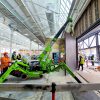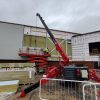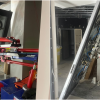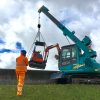Since we’re cranes mad here at GGR, we thought we’d take a closer look at the history of the treadwheel crane.
This ancestor of our compact cranes may look like a giant wooden hamster wheel but it used pure man power to help build some of the most impressive buildings in Ancient Rome and Medieval Europe.
In today’s history lesson, here’s five facts about the impressive treadwheel crane…
#1 – The treadwheel crane was invented in Ancient Rome
Although the first construction crane was invented by the Ancient Greeks, it was the innovative Romans who developed the treadwheel crane. This invention has stood the test of time as its first recorded use was in 230 BC and the design continued to be used until the late 19th century.
The wheel had a 4 to 5 metre diameter so a person or people (usually slaves) could power the machine by walking inside it.
Attached to a pulley, the crane’s rope turned onto a spindle as the wheel moved to lift the load. The load could be lowered again by the wheel being moved in the opposite direction.
This tomb carving from 100 AD shows a treadwheel crane being used as described by Roman engineer and architect Vitruvius. These first crane powered by a single man could lift around 3.5 tonnes, with a mechanical advantage of 14 to 1.
#2 – Worst job in History: the treadwheel crane operator
After the fall of the Roman empire, treadwheel cranes resurfaced again in France around 1225 but the first recorded use in Britain wasn’t until 1331.
Being a treadwheel crane operator in the Middle Ages was a dangerous job, health and safety standards weren’t quite what they are now! Cranes were built by trial and error, meaning that they often broken and killed people. Braking was also an issue, as it relied on the strength of men being able to stop the wheel from turning as quickly as possible. Not exactly the precision controls which our modern day cranes have.
Blind people were often hired to work inside the treadwheels as they would not be scared by the sight of a sheer drop below them when working at height on a building. Take a look at this video clip from an episode of The Worst Jobs in History which shows a treadwheel crane in action.
#3 – Treadwheel cranes moved around a site during a construction project
Like our UNIC mini crane range, these treadwheel cranes were able to move around a construction site but this was a more time-consuming process as they had to be dismantled and rebuilt each time.
To build the tall gothic cathedrals of the Middle Ages, treadwheel cranes would first be built on the ground then moved up the structure numerous times as it was constructed. Sometimes the cranes were left at the top of church buildings in case any repair work needed to be done.
#4 – Treadwheel cranes became dockside lifting machines
Treadwheel cranes started to be used for dockside lifting in Holland, Germany and England from the 13th century. These harbour cranes were used for loading and unloading cargo from vessels.
More powerful than the treadwheel cranes used for construction work, these permanent machines often featured two larger treadwheels for extra lifting power and were enclosed under a roof to protect the crane and workers from the rain.
There are two surviving treadwheel cranes in the UK which are Grade II* listed buildings. The crane in Guildford dates from the late 17th century was used to load and unload barges coming down the River Wey. The double wheel crane in Harwich, Essex was built in 1667 at town’s the Naval Yard.
#5 – Treadwheel cranes are still being used today
An authentic replica of the medieval treadwheel crane is being used to help create a castle as part of the Guédelon project in Burgundy, France.
A team of fifty people are taking on the challenge of building a 13th century castle using the same techniques and materials as would have been used at the time. Using stone from the local quarry, wood, sand, earth and clay, construction began in 1997 and is due to be completed around 2022.
Treadwheel cranes, or “squirrel cages” as they are commonly known on the project provide lifting power on this historically accurate build. Take a look at one of the site’s cranes lifting, slewing and creaking on the Guédelon site in this video clip.
For a more modern method of lifting, take a look at GGR’s range of pick and carry cranes, mini crawler cranes and UNIC mini spider cranes. For help choosing the right model for your job contact our technical support team at your nearest depot.
Trackback URL: https://www.ggrgroup.com/news/top-trivia-treadwheel-cranes/trackback/




